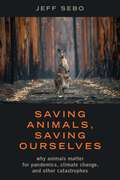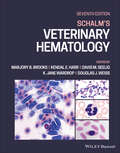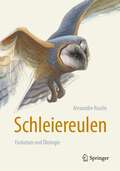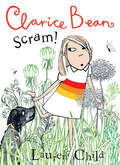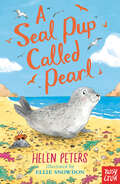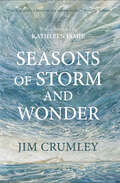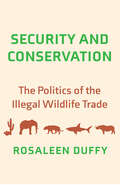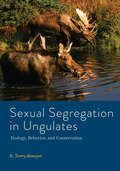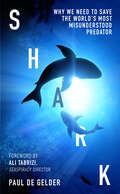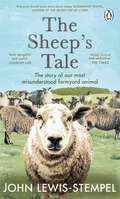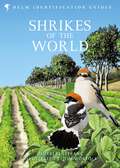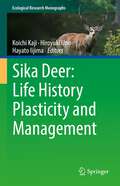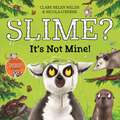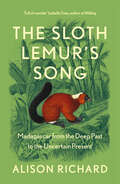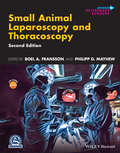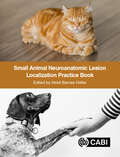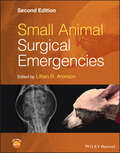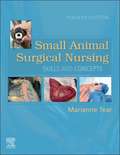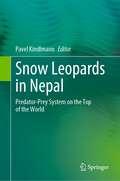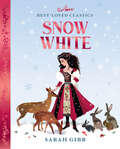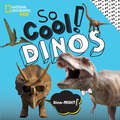- Table View
- List View
Saving Animals, Saving Ourselves: Why Animals Matter for Pandemics, Climate Change, and other Catastrophes
by Jeff SeboIn 2020, COVID-19, the Australia bushfires, and other global threats served as vivid reminders that human and nonhuman fates are increasingly linked. Human use of nonhuman animals contributes to pandemics, climate change, and other global threats which, in turn, contribute to biodiversity loss, ecosystem collapse, and nonhuman suffering. Jeff Sebo argues that humans have a moral responsibility to include animals in global health and environmental policy. In particular, we should reduce our use of animals as part of our pandemic and climate change mitigation efforts and increase our support for animals as part of our adaptation efforts. Applying and extending frameworks such as One Health and the Green New Deal, Sebo calls for reducing support for factory farming, deforestation, and the wildlife trade; increasing support for humane, healthful, and sustainable alternatives; and considering human and nonhuman needs holistically. Sebo also considers connections with practical issues such as education, employment, social services, and infrastructure, as well as with theoretical issues such as well-being, moral status, political status, and population ethics. In all cases, he shows that these issues are both important and complex, and that we should neither underestimate our responsibilities because of our limitations, nor underestimate our limitations because of our responsibilities. Both an urgent call to action and a survey of what ethical and effective action requires, Saving Animals, Saving Ourselves is an invaluable resource for scholars, advocates, policy-makers, and anyone interested in what kind of world we should attempt to build and how.
Saving H'non: Chang and the Elephant (Return to the Wild #2)
by Nguyen Thi TrangWhen Chang meets an elderly elephant named H’non, she makes a promise to rescue her from a lifetime of captivity. Together, they embark on a quest to find a new home where H’non can live as nature intended – wild and free.Created by environmental activist Trang Nguyen and award-winning manga artist Jeet Zdung, Saving H'non: Chang and the Elephant is an inspirational graphic-novel adventure, based on a true story, about a young conservationist who overcomes the odds to give H'non the elephant the life she deserves after 50 years of hardship.Chang’s daring story is for any young reader, animal lover and intrepid explorer who’s ready for adventure!PRAISE FOR SAVING SORYA: CHANG AND THE SUN BEAR– Nominated for the 2023 Yoto Carnegie Medal for Illustration– "A beautiful, moving and uplifting tale of perseverance and overcoming challenge, and how small steps can make a big difference.” - BookTrust– “I cannot praise this book enough.” Mat Tobin– "The epitome of wild and free." - Kirkus Reviews, starred review– "Stirring and gorgeously rendered, this eco-conscious tale is a superb purchase for all libraries." - School Library Journal, starred review
Schalm's Veterinary Hematology
by Marjory B. Brooks Kendal E. Harr Davis M. Seelig K. Jane Wardrop Douglas J. WeissSCHALM’S VETERINARY HEMATOLOGY An updated guide to veterinary hematology with expanded coverage on a variety of topics The revised seventh edition of Schalm’s Veterinary Hematology is updated to provide a comprehensive review of all topics related to disorders of the blood in animals. Designed as a gold-standard reference, this text covers a wide range of species in both confined and free-range populations, reflects the most recent trends in hematology diagnostics, and discusses recent advances in traditional techniques. Edited and written by an international team of experts in the field, the book represents an accessible yet in-depth resource for information on veterinary hematology. The new edition includes a hemolymphatic tissue section that covers current understanding of basic science and the species-specific hematology section is further expanded from previous editions. New chapters address emerging topics in hematology, and existing chapters have been revised and rearranged to improve readability and simplify access to the material. This seventh edition: Updates the most complete reference on veterinary hematology across species Contains a new section on basic biology of hemolymphatic tissues Expands coverage of species-specific hematology Presents new and emerging topics in blood disorders and diagnostic techniques Features a reorganized contents list for an integrated, easy to use reference Written for veterinary clinical pathologists and residents, diagnostic laboratory staff, internists, and specialists, Schalm’s Veterinary Hematology is the most comprehensive and up-to-date reference on the topic.
Schalm's Veterinary Hematology
by Marjory B. Brooks Kendal E. Harr Davis M. Seelig K. Jane Wardrop Douglas J. WeissSCHALM’S VETERINARY HEMATOLOGY An updated guide to veterinary hematology with expanded coverage on a variety of topics The revised seventh edition of Schalm’s Veterinary Hematology is updated to provide a comprehensive review of all topics related to disorders of the blood in animals. Designed as a gold-standard reference, this text covers a wide range of species in both confined and free-range populations, reflects the most recent trends in hematology diagnostics, and discusses recent advances in traditional techniques. Edited and written by an international team of experts in the field, the book represents an accessible yet in-depth resource for information on veterinary hematology. The new edition includes a hemolymphatic tissue section that covers current understanding of basic science and the species-specific hematology section is further expanded from previous editions. New chapters address emerging topics in hematology, and existing chapters have been revised and rearranged to improve readability and simplify access to the material. This seventh edition: Updates the most complete reference on veterinary hematology across species Contains a new section on basic biology of hemolymphatic tissues Expands coverage of species-specific hematology Presents new and emerging topics in blood disorders and diagnostic techniques Features a reorganized contents list for an integrated, easy to use reference Written for veterinary clinical pathologists and residents, diagnostic laboratory staff, internists, and specialists, Schalm’s Veterinary Hematology is the most comprehensive and up-to-date reference on the topic.
Schleiereulen: Evolution und Ökologie
by Alexandre RoulinDie Schleiereulen sind mit ihrem herzförmigen Gesicht, dem gelbbraunen Rücken und Flügeln und der reinweißen Unterseite ein unverwechselbarer und beliebter Vogel. Sie haben im Laufe der Geschichte Menschen aus vielen Kulturen fasziniert. Alexandre Roulin schildert in diesem Buch, welche evolutionären Anpassungen diesen Vogel so erfolgreich gemacht haben und wie sich die zunehmenden menschlichen Störungen auf die Tiere auswirken. Er beschreibt Evolution, Ökologie und Verhalten der Schleiereule und ihrer Verwandten und bespricht Themen wie das hohe Reproduktionspotenzial, Physiologie, soziale und familiäre Interaktion, ausgeprägte Farbvariation und globale Verbreitung sowie Phylogenie. Der Text ist leicht zugänglich. Ein besonderes Highlight sind die künstlerischen Zeichnungen. Das Buch richtet sich sowohl an Forscher, Studierende der Ornithologie, Verhaltensbiologie, Ökologie, Naturschutz- und Evolutionsbiologie als auch an Hobby-Ornithologen und Naturliebhaber.
Scram! (Clarice Bean)
by Lauren ChildThe exceptionordinary, effervescent Clarice Bean is back with her trademark heart and humour in this beautifully illustrated story by former Children’s Laureate Lauren Child – a delightful summer read for the entire family!
A Seal Pup Called Pearl (The Jasmine Green Series #13)
by Helen PetersThe thirteenth in a fantastic series of animal stories for younger readers by Waterstones Children's Book Prize-shortlisted author Helen Peters, with beautiful black-and-white illustrations by Ellie Snowdon.Jasmine's dad is a farmer, and her mum is a large-animal vet, so Jasmine spends a lot of time caring for animals and keeping them out of trouble. Unfortunately, this often means she gets into hot water herself...When a newborn seal pup is abandoned on the riverbank, Jasmine and Tom are determined to care for her until she's old enough to be released. But there are other dangers for baby seals, and when Pearl's life is threatened again, nobody knows what the future will hold. Will Pearl ever be able to return to the sea?Brilliant storytelling that will make you laugh and cry, this is Dick King-Smith for a new generation. Perfect for readers aged seven and up.Check out Jasmine's other adventures: A Piglet Called Truffle, A Kitten Called Holly, A Sheepdog Called Sky and many more!
Seasons of Storm and Wonder
by Jim CrumleyFrom Jim Crumley, the "pre-eminent Scottish nature-writer” (Guardian), this landmark volume documents the extraordinary natural life of the Scottish Highlands and bears witness to the toll climate chaos is already taking on our wildlife, habitats and biodiversity – laying bare what is at stake for future generations. A display of head-turning autumn finery on Skye provokes Jim Crumley to contemplate both the glories of the season and how far the seasons themselves have shapeshifted since his early days observing his natural surroundings. After a lifetime immersed in Scotland's landscapes and enriched by occasional forays in other northern lands, Jim has amassed knowledge, insight and a bank of memorable imagery chronicling the wonder, tumult and spectacle of nature’s seasonal transformations. He has witnessed not only nature’s unparalleled beauty, but also how climate chaos and humankind has brought unwanted drama to wildlife and widespread destruction of ecosystems and habitats. In this landmark volume, Jim combines lyrical prose and passionate eloquence to lay bare the impact of global warming and urge us all towards a more daring conservation vision that embraces everything from the mountain treeline to a second spring for the wolf.
Security and Conservation: The Politics of the Illegal Wildlife Trade
by Rosaleen DuffyAn exploration of the scale, practical reality, and future implications of the growing integration of biodiversity conservation with global security concerns “There are few keener observers of international biodiversity conservation than Rosaleen Duffy. With a ferocity of purpose, she investigates the tenuous connection and nuances among illegal wildlife trade, terrorism threats, and national security.”—Steven R. Brechin, Rutgers University, New Brunswick Debates regarding environmental security risks have generally focused on climate change and geopolitical water conflicts. Biodiversity conservation, however, is increasingly identified as a critical contributor to national and global security. The illegal wildlife trade is often articulated as a driver of biodiversity losses, and as a source of finance for organized crime networks, armed groups, and even terrorist networks. Conservationists, international organizations, and national governments have raised concerns about “convergence” of wildlife trafficking with other serious offenses, including theft, fraud, corruption, drugs and human trafficking, counterfeiting, firearms smuggling, and money laundering. In Security and Conservation, Rosaleen Duffy examines the scale, practical reality, and future implications of the growing integration of biodiversity conservation with global security concerns. Duffy takes a political ecology approach to develop a deeper understanding of how and why wildlife conservation turned toward security‑oriented approaches to tackle the illegal wildlife trade.
Sexual Segregation in Ungulates: Ecology, Behavior, and Conservation (Wildlife Management and Conservation)
by R. Terry BowyerWhy does it benefit some male and female animals to live separately?Sexual segregation, wherein the sexes of a species live apart for long periods of time, has far-reaching consequences for the ecology, behavior, and conservation of hooved mammals, which are called ungulates. Award-winning researcher R. Terry Bowyer has spent the past four decades unravelling the causes and consequences of this perplexing phenomenon by studying ungulates and the large carnivores that prey upon them. In Sexual Segregation in Ungulates, Bowyer's critical, thought-provoking approach helps resolve long-standing disagreements concerning sexual segregation and offers future pathways for species and habitat conservation. He highlights important elements of the natural history of wild ungulate species, including bighorn sheep and elk. He then uses this perspective to frame and test hypotheses illuminating the motivations behind sexual segregation. He investigates the role of sexual segregation in mechanisms underpinning ungulate mating systems, sexual dimorphism, paternal behavior, and population dynamics. Bowyer's research spans ecosystems from deserts to the Arctic and involves most species of ungulates inhabiting the North American continent. He also provides a timely review of sexual segregation for species of plants and other animals, including humans. Covering definitions, theory, findings, and practical applications of related study, Bowyer describes the behavioral patterns related to sexual segregation, explains how to detect these patterns, and considers the implications of sexual segregation for new approaches to conservation and management of ungulates and other species of wildlife.This book is essential reading for scientists and all those interested in the conservation and management of species, including wildlife professionals, hunters, outdoor enthusiasts, and naturalists.
Shark: Why We Need To Save The World's Most Misunderstood Predator
by Paul de GelderFrom shark attack survivor to the shark’s biggest advocate, Paul de Gelder tells us just why these majestic diverse animals need our help as much as we need them.
The Sheep’s Tale: The story of our most misunderstood farmyard animal
by John Lewis-Stempel'An important book on several levels... Read a few sentences out loud, wherever you are.' Rosamund YoungI look at the Ryeland ewes, white and fat with fecundity. Replete with contentment. Contentment is a transmissible condition. I catch it off the sheep. The old time shepherds used to sleep with their sheep, out in the fields. I do it sometimes too, on the dry nights, the sheep lying down around me. I'm not sure on those nights who is protecting whom.Everybody thinks they know what sheep are like: they're stupid, noisy, cowardly ('lambs to the slaughter'), and they're 'sheepwrecking' the environment.Or maybe not. Contrary to popular prejudice, sheep are among the smartest animals in the farmyard, fiercely loyal, forming long and lasting friendships. Sheep, farmed properly, are boons to biodiversity. They also happen to taste good and their fleeces warm us through the winter - indeed, John Lewis-Stempel's family supplied the wool for Queen Elizabeth's 'hose'.Observing the traditional shepherd's calendar, The Sheep's Tale is a loving biography of ewes, lambs, and rams through the seasons. Lewis-Stempel tends to his flock with deep-rooted wisdom, ethical consideration, affection, and humour. This book is a tribute to all the sheep he has reared and sheared - from gregarious Action Ram to sweet Maid Marion. In his inimitable style, he shares the tales that only a shepherd can tell.
Shrikes of the World
by Norbert Lefranc'This long-awaited update to the acclaimed first edition is the definitive guide to a complex and intriguing family. The species accounts and taxonomic treatments have been fully revised in line with recent studies, and the all-new plates and photos complete this remarkable work. Highly recommended.' – Dominic MitchellBeautiful, colourful, often fearless hunters of large insects and small vertebrates, shrikes are among the most admired of all avian groups. The group is widespread (particularly in the Old World) with a large number of species, though many populations have plummeted in recent years, especially in Europe.This is a second edition of Norbert Lefranc's Shrikes, fully updated from its 1997 predecessor. The introductory texts have been significantly expanded and six new sections have been added in the species accounts: vagrancy, foraging behaviour, breeding success, population trends, conservation and taxonomic notes. Special attention has been given to the latest developments in shrike systematics, not forgotten by the DNA revolution. The speciesaccounts give information about the past and current distribution, along with threats and conservation status. Detailed and fully revised maps accompany the authoritative text, along with hundreds of high-quality photos showcasing racial and ageing differences as well as interesting aspects of shrike behaviour. An exceptional new series of plates by Tim Worfolk have been created, with more individual plumages shown than in the previous edition.This beautiful book represents the definitive account of shrikes and their relationships, appearance, conservation and lifestyle; it will be treasured by birdwatchers and professional ornithologists alike.
Sika Deer: Life History Plasticity and Management (Ecological Research Monographs)
by Koichi Kaji Hiroyuki Uno Hayato IijimaThis book provides complete and up-to-date information on sika deer biology and its management, focusing on their life history with an integrated approach of population dynamics, morphology, genetics, and evolution. The expanding distribution of sika and its increase in population in Japan and other countries are causing damage to agriculture and forestry, impacting ecosystems and affecting other species. We are facing conflicting deer issues regarding the conservation of resource values and pest control of sika deer. This contributed volume compiles new findings focusing on the ecological plasticity of the sika deer. It aims to clarify the ecological characteristics of the deer by integrating studies of different approaches and provides a perspective for their management. The book consists of six parts. Part I introduces the ecological and management background behind the history of sika deer. The following four parts discuss movement ecology (Part II), impact on vegetation and bottom-up effect on sika deer (Part III), impact on ecosystem and its resilience (Part IV), and comparison of life-history characteristics between sika deer and other ungulate species (Part V). The last part (Part VI) covers the science-based management of sika deer. Contributed by recognized experts and young researchers of sika deer, this book appeals to researchers and professionals in wildlife biology and wildlife management, evolution, population dynamics, morphology, genetics, and reproductive physiology.
Slime? It's Not Mine! (Lenny Learns About . . . #3)
by Clare Helen WelshA laugh-out-loud funny story, full of animal facts and . . . SLIME.Lenny the lemur is on holiday in California. He's having a wonderful time swinging through the redwood trees, when – ew – he gets slimed! Lenny is determined to find the source of the slime, so off he sets . . .Lenny meets lots of slime-producing animals on his quest, including opossums, dolphins, salamanders and sea-lions. But which one is the sneaky slime-maker who slimed Lenny . . .?The follow-up to Poo! Is That You? and Wee? It's Not Me! from Clare Helen Welsh and the award-winning Nicola O'Byrne.Includes an information spread at the end with animal facts.
The Sloth Lemur’s Song: Madagascar From The Deep Past To The Uncertain Present
by Alison Richard‘Full of wonder and forensic intelligence’ Isabella Tree, author of Wilding A moving account of Madagascar told by a researcher who has spent over fifty years investigating the mysteries of this remarkable island.
Small Animal Laparoscopy and Thoracoscopy (AVS Advances in Veterinary Surgery)
by Boel A. Fransson Philipp D. MayhewThe newly revised Second Edition of Small Animal Laparoscopy and Thoracoscopy is a rigorous update of the first book to provide comprehensive and current information about minimally invasive surgery in dogs and cats. With a focus on techniques in rigid endoscopy, the book also includes guidance on additional surgeries outside the abdomen and chest. New chapters describe newly developed surgical techniques, while existing chapters have been thoroughly updated. The authors include detailed stepwise instructions for each procedure, including clinical photographs. Pre-operative considerations, patient positioning, portal placement, and postoperative care are also discussed, with key points of consideration outlined for each surgery. Purchasers of the book will also receive access to a companion website featuring video clips of the fundamental skills and surgical techniques described in the resource. The book also offers: An introduction to laparoscopic suturing and knot tying with accompanying video tutorials A thorough introduction to the equipment used in laparoscopic and thoracoscopic veterinary surgeries, including imaging equipment, surgical instrumentation, energy devices, and stapling equipment Clear explanations of foundational techniques in laparoscopy, including laparoscopic anesthesia, access techniques, contraindications, complications, and conversion Robust descriptions of fundamental techniques in thoracoscopy, including patient positioning, port placement, contraindications, complications, and conversion Discussions of a wide variety of laparoscopic and thoracoscopic surgical procedures Small Animal Laparoscopy and Thoracoscopy is an essential reference for veterinary surgeons, veterinary internal medicine specialists and residents, and small animal general practitioners seeking a one-stop reference for minimally invasive surgery in dogs and cats.
Small Animal Laparoscopy and Thoracoscopy (AVS Advances in Veterinary Surgery)
by Boel A. Fransson Philipp D. MayhewThe newly revised Second Edition of Small Animal Laparoscopy and Thoracoscopy is a rigorous update of the first book to provide comprehensive and current information about minimally invasive surgery in dogs and cats. With a focus on techniques in rigid endoscopy, the book also includes guidance on additional surgeries outside the abdomen and chest. New chapters describe newly developed surgical techniques, while existing chapters have been thoroughly updated. The authors include detailed stepwise instructions for each procedure, including clinical photographs. Pre-operative considerations, patient positioning, portal placement, and postoperative care are also discussed, with key points of consideration outlined for each surgery. Purchasers of the book will also receive access to a companion website featuring video clips of the fundamental skills and surgical techniques described in the resource. The book also offers: An introduction to laparoscopic suturing and knot tying with accompanying video tutorials A thorough introduction to the equipment used in laparoscopic and thoracoscopic veterinary surgeries, including imaging equipment, surgical instrumentation, energy devices, and stapling equipment Clear explanations of foundational techniques in laparoscopy, including laparoscopic anesthesia, access techniques, contraindications, complications, and conversion Robust descriptions of fundamental techniques in thoracoscopy, including patient positioning, port placement, contraindications, complications, and conversion Discussions of a wide variety of laparoscopic and thoracoscopic surgical procedures Small Animal Laparoscopy and Thoracoscopy is an essential reference for veterinary surgeons, veterinary internal medicine specialists and residents, and small animal general practitioners seeking a one-stop reference for minimally invasive surgery in dogs and cats.
Small Animal Neuroanatomic Lesion Localization Practice Book
by Susan Arnold Joy Delamaide Gasper Kari Foss Julian Guevar Devon Hague Sam Long Simon Platt Helena RylanderNeuroanatomic lesion localization (detecting where a neurologic problem arises) is key when presented with a dog or cat with signs of neurologic disease. The correct neuroanatomic lesion localization will drive veterinarians towards an appropriate list of differential diagnoses and help lead the client towards applicable diagnostic investigation. Neuroanatomic lesion localization is the first step when managing any pet with signs of neurologic disease. Despite its importance, it remains a challenge for veterinary students, residents and practitioners in their daily practice. Laid out in a case-based format and workbook style to guide the reader through neuroanatomic lesion localization, this book: Covers the whole process from the animal's examination through to diagnosis; Includes localizations of intercranial disease, spinal cord disease, neuromuscular disease and multifocal disease; Provides blank practice sheets to encourage the reader to work through cases, testing and consolidating their knowledge multiple times. Written by a team of eminent, international veterinary neurologists, this book is an invaluable resource for veterinary students and practitioners looking to expand their skills in veterinary neurology.
Small Animal Surgical Emergencies
by Lillian R. AronsonSmall Animal Surgical Emergencies A comprehensive and up-to-date guide in emergency surgical intervention for veterinary professionals Small Animal Surgical Emergencies, Second Edition continues to be an important resource focusing on surgical emergencies, combining the work of surgical specialists and critical care specialists, and filling a void in educating and informing veterinarians. The new edition of this book provides updated information on an array of topics such as preoperative stabilization, new and innovative treatment options, and aftercare. Each chapter covers step-by-step information on emergency stabilization, diagnostic approach, operative techniques, postoperative care, common complications encountered in each case, and how to troubleshoot any such complication should they occur. It also offers simplified surgical techniques to ensure success and describes new and novel procedures throughout. The Second Edition of Small Animal Surgical Emergencies features: Nine new chapters covering operating room nursing tips, rectal prolapse, colonic torsion, surgical intervention post celiotomy, assisted enteral feeding tubes, open chest CPR, managing complications of skin flaps and grafts, incisional infection, and joint luxations Many chapters are written in collaboration by experts in small animal surgery and critical care, combining these practices in one important resource Relevant anatomy, imaging, and full-color illustrations and drawings incorporated into each chapter Inclusion of case presentations, when relevant An important tool for small animal general practitioners, veterinary surgeons, critical care specialists, as well as veterinary nurses and operating room technicians, Small Animal Surgical Emergencies, Second Edition is a crucial resource for this constantly evolving branch of veterinary medicine.
Small Animal Surgical Emergencies
by Lillian R. AronsonSmall Animal Surgical Emergencies A comprehensive and up-to-date guide in emergency surgical intervention for veterinary professionals Small Animal Surgical Emergencies, Second Edition continues to be an important resource focusing on surgical emergencies, combining the work of surgical specialists and critical care specialists, and filling a void in educating and informing veterinarians. The new edition of this book provides updated information on an array of topics such as preoperative stabilization, new and innovative treatment options, and aftercare. Each chapter covers step-by-step information on emergency stabilization, diagnostic approach, operative techniques, postoperative care, common complications encountered in each case, and how to troubleshoot any such complication should they occur. It also offers simplified surgical techniques to ensure success and describes new and novel procedures throughout. The Second Edition of Small Animal Surgical Emergencies features: Nine new chapters covering operating room nursing tips, rectal prolapse, colonic torsion, surgical intervention post celiotomy, assisted enteral feeding tubes, open chest CPR, managing complications of skin flaps and grafts, incisional infection, and joint luxations Many chapters are written in collaboration by experts in small animal surgery and critical care, combining these practices in one important resource Relevant anatomy, imaging, and full-color illustrations and drawings incorporated into each chapter Inclusion of case presentations, when relevant An important tool for small animal general practitioners, veterinary surgeons, critical care specialists, as well as veterinary nurses and operating room technicians, Small Animal Surgical Emergencies, Second Edition is a crucial resource for this constantly evolving branch of veterinary medicine.
Small Animal Surgical Nursing - E-Book
by Marianne TearMaster the veterinary technician's role and skills in surgical assisting! Small Animal Surgical Nursing, 4th Edition helps you learn the protocols and techniques you need to work together with the veterinarian as a smoothly functioning surgical team. Clear guidelines are provided in areas such as surgical instruments and procedures, anesthesia, patient monitoring, preoperative and postoperative care of the animals, pain management, and client education. This edition is updated throughout and includes timed instrument identification exercises on the Evolve website. Written by well-known educator Marianne Tear, this comprehensive resource ensures that you are highly competent in performing all of the vet tech’s surgical responsibilities.Coverage of small animal surgical nursing provides a full review of the role and responsibilities of the veterinary technician in the surgical setting, including sterilization, protocols, gowning, gloving, anesthesia, wound management, and care of the animals before and after surgery.Focus on exceptional clinical skills and practice tips draws from the author’s real-world experiences of what is most commonly encountered in the clinical setting.Nearly 500 full-color illustrations and photographs show surgical equipment, instruments, sterile techniques, suturing techniques, and wound management.Attention to detail ensures understanding of the skills covered in required veterinary technician surgical nursing courses.Learning Objectives and Key Terms at the beginning of each chapter identify the material that should be mastered in the upcoming chapter.Key Points and Review Questions at the end of each chapter facilitate study and reinforce understanding.Quick Reference for Common IV Infusions and Analgesic Protocols appendix helps students learn to work quickly and efficiently.NEW! Updated content and new protocols and skills ensure that students have the latest information available.NEW! Updated and additional Review Questions include multiple-choice, listing, and open-ended questions that challenge students to apply the knowledge they have learned in each chapter.
Snow Leopards in Nepal: Predator-Prey System on the Top of the World
by Pavel KindlmannSnow leopard (Panthera uncia) is an endangered species, and its population size is steadily declining. The main threats to the snow leopard include illegal trade, conflict with locals (human-snow leopard conflict), lack of conservation, awareness and policy, and climate change. To avoid its extinction, we badly need a good knowledge of its ecology, distribution and population dynamics, including interactions with its prey, which will take into account various scenarios of changes in climate and human impact on snow leopard. This book aims to put together a considerable amount of unpublished data collected by the co-author of most of the chapters, Bikram Shrestha, which might be useful for other researchers working on snow leopard. In addition, researchers might find it useful to have a key for determining the diet of snow leopard based on remnants of its food in its scats. Last, but not least, based on the difficulty we experienced trying to compare and combine different sets of results, we propose a general methodology for collecting data. Thus, this book is not an all-encompassing compendium, but an attempt to fill some gaps in the literature and to show, how to publish new data on snow leopard in a useful and workable way. The first part, describing the main features of snow leopard and its main prey ecology, is followed by a comprehensive review of data available on its abundance and threats to its survival. The third, most extensive part—the substance of the book—presents new data from 15 years of intensive camera trapping combined with scat sampling. These data are analyzed by means of advances GIS and genetic techniques, which yields a large amount of conservation implications.The purpose of this book is to provide a tool for both environmental managers and researchers to find quickly what is known about this species for conservation planning and for an effective protection of snow leopard. However, enthusiasts interested in wild cats may welcome the book, too.
Snow White (Best-Loved Classics)
by Sarah GibbA beautifully illustrated, magical retelling of one of the most beloved children’s fairy tales.
So Cool! Dinos (National Geographic Kids)
by National Geographic KidsThose sharp, pointy teeth! Those terrifying claws! Those spikey spines and ferocious roars! Let's face it…dinosaurs are SO COOL! And, well, so is this book!
